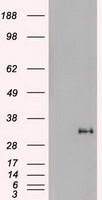Noggin (NOG) Mouse Monoclonal Antibody [Clone ID: OTI1H8]
CAT#: CF500029
Carrier-free (BSA/glycerol-free) Noggin mouse monoclonal antibody, clone OTI1H8 (formerly 1H8)
Formulation: Standard
Specifications
| Product Data | |
| Clone Name | OTI1H8 |
| Applications | IF, IHC, WB |
| Recommended Dilution | WB 1:20000~40000, IHC 1:50, IF 1:100 |
| Reactivities | Human, Mouse, Rat |
| Host | Mouse |
| Isotype | IgG2b |
| Clonality | Monoclonal |
| Immunogen | Human recombinant protein fragment corresponding to amino acids 28-232 of human noggin (NP_005441) produced in E.coli. |
| Formulation | Lyophilized powder (original buffer 1X PBS, pH 7.3, 8% trehalose) |
| Reconstitution Method | For reconstitution, we recommend adding 100uL distilled water to a final antibody concentration of about 1 mg/mL. To use this carrier-free antibody for conjugation experiment, we strongly recommend performing another round of desalting process. (OriGene recommends Zeba Spin Desalting Columns, 7KMWCO from Thermo Scientific) |
| Purification | Purified from mouse ascites fluids or tissue culture supernatant by affinity chromatography (protein A/G) |
| Conjugation | Unconjugated |
| Storage | Store at -20°C as received. |
| Stability | Stable for 12 months from date of receipt. |
| Predicted Protein Size | 23.7 kDa |
| Gene Name | noggin |
| Database Link | |
| Background | Noggin is a secreted polypeptide which binds and inactivates members of the transforming growth factor-beta (TGF-beta) superfamily signaling proteins, such as bone morphogenetic protein-4 (BMP4). By diffusing through extracellular matrices more efficiently than members of the TGF-beta superfamily, it may have a principal role in creating morphogenic gradients. Noggin appears to have pleiotropic effect, both early in development as well as in later stages. The results of the mouse knockout of the ortholog suggest that noggin is involved in numerous developmental processes, such as neural tube fusion and joint formation. Recently, several dominant human NOG mutations in unrelated families with proximal symphalangism (SYM1) and multiple synostoses syndrome (SYNS1) were identified; both SYM1 and SYNS1 have multiple joint fusion as their principal feature, and map to the same region (17q22) as this gene. All of these mutations altered evolutionarily conserved amino acid residues. The amino acid sequence of this human gene is highly homologous to that of Xenopus, rat and mouse. |
| Synonyms | SYM1; SYNS1; SYNS1A |
| Reference Data | |
| Protein Families | Druggable Genome, Secreted Protein |
| Protein Pathways | TGF-beta signaling pathway |
Documents
| Product Manuals |
| FAQs |
| SDS |
Resources
| Antibody Resources |
Other Versions
| SKU | Description | Size | Price |
|---|---|---|---|
| TA500029 | Noggin (Noggin) mouse monoclonal antibody, clone OTI1H8 (formerly 1H8) |
USD 447.00 |
|
| TA500029AM | Noggin (Noggin) mouse monoclonal antibody, clone OTI1H8 (formerly 1H8), Biotinylated |
USD 509.00 |
|
| TA500029BM | Noggin (Noggin) mouse monoclonal antibody, clone OTI1H8 (formerly 1H8), HRP conjugated |
USD 509.00 |
|
| TA500029S | Noggin (Noggin) mouse monoclonal antibody, clone OTI1H8 (formerly 1H8) |
USD 200.00 |
{0} Product Review(s)
Be the first one to submit a review






























































































































































































































































 Germany
Germany
 Japan
Japan
 United Kingdom
United Kingdom
 China
China









